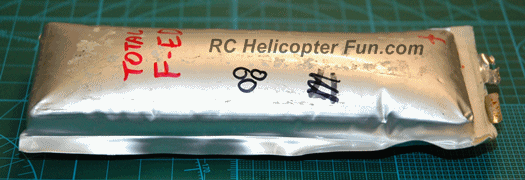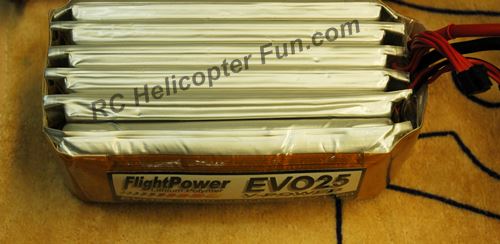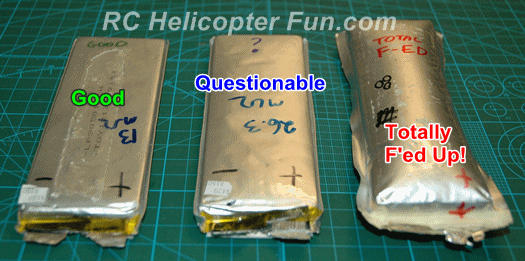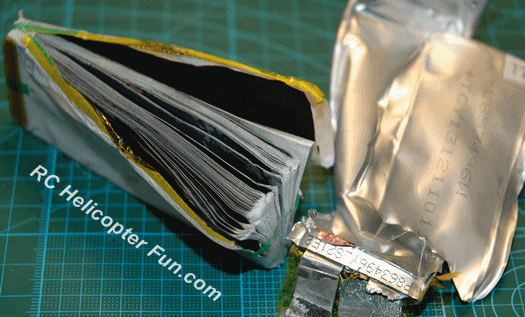How To Repair Swollen Lipo Battery
Puffed LiPo Batteries - Oops!
past John Salt - Last Updated August 2021
I really got an appreciation of how strong a LiPo bombardment cell is when LiPo puffing occurs.
 Puffed LiPo Jail cell
Puffed LiPo Jail cell
The to a higher place movie shows a 5000 mAh cell that had shorted internally during a flying. This one cell experienced thermal delinquent, completely puffed out and got very hot! Too hot to touch in fact, and I was sure the entire LiPo pack was going to blow subsequently I landed.
 Puffed/Swolen LiPo Prison cell In 6S Battery Pack
Puffed/Swolen LiPo Prison cell In 6S Battery Pack
That was not the case however and the plastic pouch cell contained all the vaporized electrolyte (process called gassing). It was tight as a pulsate mind y'all, but no venting or fire occurred.
What Causes LiPo Puffing?
Every bit was just mentioned, a puffed LiPo cell is caused by gassing of the electrolyte. If you really desire to print your buddies out at the flying field or race track, tell them this procedure is called "electrolyte decomposition."
Electrolyte decomposition is the chemic breakdown of the electrolyte into its primary elements, mostly lithium and oxygen (lithium oxide - Li2O).
This chemical compound volition be deposited on the anodes or cathodes of the cell (depending if you are over charging or over discharging). The puffing happens when excess oxygen in this reaction is also released. Another reason why LiPo'due south are even more flammable during/subsequently puffing - they can incorporate a fair amount of oxygen.
A practiced number of other elements & compounds are too released as the electrolyte decomposes such as CO2, but the main ones we should know about are Li2O with excess O2.If yous want a deeper understanding of the chemistry involved in this complex process,here's a good commodity.
Is it normal to experience swollen or puffed LiPo packs? Can I still employ a LiPo that is puffed?
As we simply found out, LiPo cells tin can & will peachy. Information technology'southward really somewhat normal as they historic period since electrolyte decomposition is occurring all the time. The speed at which it occurs, and if excess O2 or CO2 is released, is based on many factors including how difficult you run (belch) the packs, how fast y'all accuse them, how you store them, their age, the quality of the packs, and of grade how much they heat up during apply.
A LiPo battery / prison cell can therefore puff during a unmarried calumniating use or puff very slowly over many months/years of normal usage. They tin can likewise slowly puff while sitting unused in a fully discharged or charged land for many months/years.
 Levels of LiPo puffing from none on the left, to drum tight on the correct.
Levels of LiPo puffing from none on the left, to drum tight on the correct.
As long as information technology is very minor LiPo puffing & goes away afterwards the pack cools downward, information technology has been my feel that you can usually still safely employ the pack and keep the swelling in check; likely non to its total discharge potential however.
This doesn't apply to puffed LiPo packs that have sat in storage fully charged or discharged as their puffing is likewise associated with catastrophic anode/cathode oxidation & electrolyte decomposition. Information technology has been my experience over the past decade that LiPo's that puffed upwards while in storage for long periods of time were all 100% useless afterward .
Remember in the LiPo write-upward where I mentioned the importance of having the internals of the LiPo cell (anode, cathode, & polymer separator), all pressed and held tightly together for maximum ion exchange, which in turn provides the lowest possible LiPo internal resistance. What do think happens when the jail cell puffs up slightly?
 LiPo Battery Ion Efficiency & Low Internal Resistance Requires The Many Anode & Cathode Layers To Be Firmly Pressed Against The Polymer Separator Film
LiPo Battery Ion Efficiency & Low Internal Resistance Requires The Many Anode & Cathode Layers To Be Firmly Pressed Against The Polymer Separator Film
Yeah, that strong "pressed" lamination bond between all those layers, can be compromised, non to mention the electrolyte has partially broken downward. Which in plow increases the internal resistance, which creates more heat while used, which creates even more puffing and can lead to good old thermal delinquent!
Every "puffing" incident will be different depending on how much LiO2 & backlog O2 has formed, and how much internal delamination between layers occurs.
If the internal resistance of a swollen cell is significantly higher than the other/s in the pack, that would be a damn practiced indicator too much Li2O has formed on the anode/cathode, and/or the bond betwixt layers has weakened as well much, and good reason tostop using that pack right away.
If however the internal resistance has non increased much with that slightly puffed cell, then it'due south still likely okay to use with relative safely, if you are careful.
As packs age, the swelling can and normally volition get worse. Information technology's basically a positive feedback loop. The initial puffing incident causes the resistance to increase, causing the packs to run hotter, increasing gassing, making the puffing & delamination worse, decreasing ion exchange efficiency, increasing resistance even more.
As a LiPo pack/cell is nearing the finish of information technology's useful life information technology can bear witness some very pocket-sized swelling that won't go away, even after the pack cools. This pack may even so have some dainty non aggressive flights or drives left in information technology, or it could be a ticking time bomb that is primed for a thermal runaway issue!
Some feel once a LiPo bombardment is showing any swelling whatsoever that won't go away, they are not safety to use and must exist disposed of.
My ain experience over the past 11 years is equally long as the internal resistances between slightly puffed & not puffed cells remain fairly equal, they all still residuum upwardly fine during the charge cycle, and they all still accept most of their charge capacity; as long as you treat them kindly with gentler flight/driving, yous can mostly become more safety cycles out of them.
Yet, you are doing so at your own risk!
When in doubt, transport permanently puffed LiPo packs/cells to the LiPo *grave 1000 ( once fully discharged ).
*Check your local city office, waste disposal service, recycling facility/s or where you purchased your LiPo from for LiPo battery recycling / disposal options in your area.
Puffed Lipo Fixes
Despite what you lot may take read or seen others practice on the skillful sometime interweb, there is no safe or realistic way to vent or "de-puff" a swollen LiPo jail cell or bombardment and expect it to concluding afterward.
Regardless of excess build up of Li2O, possible delamination, and decreased ion commutation efficiency which have all occurred; if you poke a tiny hole through the prison cell to vent the O2, you take just introduced another problem - air contamination. The LiPo manufacturing procedure is critical to a clean room environment and zippo humidity. Water vapor, even in tiny amounts will quickly cause more unwanted reactions within the jail cell and produce even more off gassing.
I've tried to vent puffed LiPo cells numerous times, even in a clear plastic bag filled with inert argon welding gas during the process. I pressed the jail cell tight after it vented, so sealed the tiny pin prick hole.
Internal resistance on every swollen cell I've tried this on increased very quickly afterward during the start use, and soon the cells were more bloated than before with off the chart internal resistance values.
All were useless and dangerous later! DON'T vent puffed cells!
Source: https://www.rchelicopterfun.com/puffed-lipo.html
Posted by: deanoural1946.blogspot.com



0 Response to "How To Repair Swollen Lipo Battery"
Post a Comment